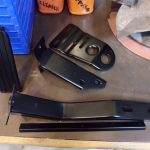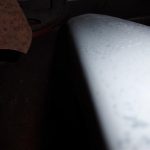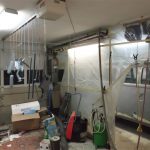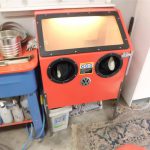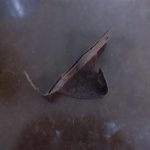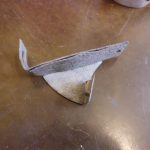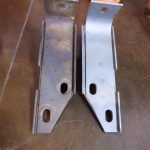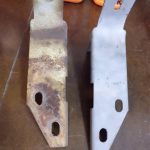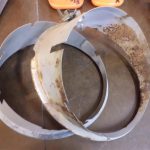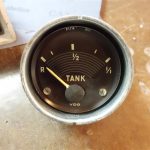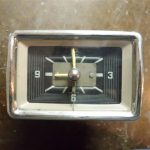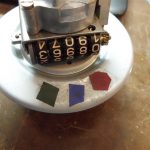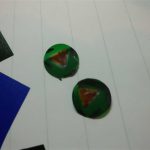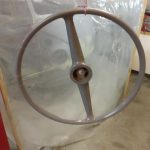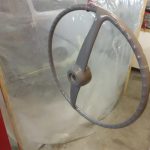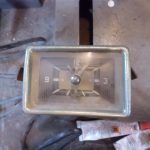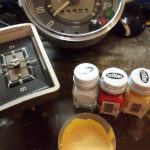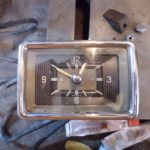Kumulus Weiß und See Blau!
The color coats arrived today; the bus will be Cumulus White on the inside and top, and “Sea Blue” (Lake Blue) on the bottom to match the original color scheme. I was able to get one white part far enough along in the prep process to paint as a color test, it’s an extremely close match to an area of protected original cumulus white I found and polished. Unfortunately the sea blue doesn’t match a protected original sea blue area that I found and polished. There were multiple sea blues in ’67, both sharing the same VW paint code, so that’s likely the source of confusion; one was darker and less green (the original bus color) and the other was lighter with a green/teal tint (what was sent). The paint supplier has been great so far so hopefully this won’t be a problem to fix.
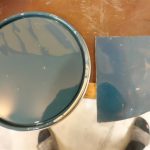
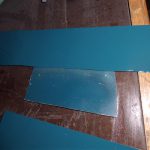
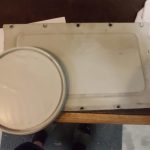
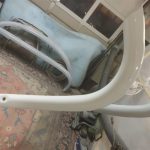
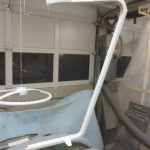
Small Part Progress
Another round of primer was completed on the current batch of small parts being restored. The bumper over-riders are becoming very smooth and the rust pits are no longer visible. In the process of painting the small parts on the opposite side of the garage I found that the over spray that does occur is just dust by the time it reaches the cabinets. Because of this I took down part of the bus bubble to re-gain working room and improve lighting.
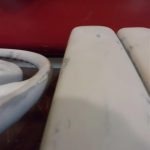

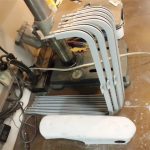

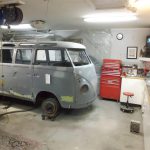
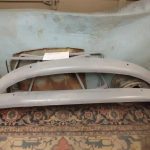
First Chassis Parts Painted
High-Build Primer for Small Parts
One of the pop-out window frames was media blasted and all of the small parts that were epoxy primed earlier in the week were primed with high-build urethane primer. The purpose of the epoxy primer is to seal out moisture and form a protective shell around the metal, however it is not easily sand-able as it quickly clogs sandpaper. The purpose of the high-build urethane primer is to fill small surface imperfections to create a smooth surface, the urethane primer is readily sand-able and meant for this purpose. The right picture isn’t great but it shows how this works, the let side of the part has been sanded and the holes left by the rust pits are much shallower, the right side is unsanded and the holes left by the rust pits are still very deep. (compare to the un-blasted part at far left) Further sanding and additional coats of high-build primer (if needed) will yield a perfectly flat surface.
Epoxy Priming of Small Parts
Headlight Assembly Restoration
The headlight assemblies that were media blasted yesterday were primed and painted today. Once the paint was dry the bezels and lens were cleaned and polished, then everything was re-assembled. More media blasting was completed on the vent window frames and other miscellaneous parts. The pop-out windows were disassembled; all of the rubber was dry-rotted so it took considerable time picking all of the rubber out of the sealing channels before the screws could be loosened to separated the frame halves and release the glass. There was substantial rust and the screws are tiny, so many had to be drilled out. Most of the frames can be salvaged and the drilled screw-holes re-tapped for slightly over-sized screws. (The head of the over-sized screws is the same size, so no difference will be visible once assembled)
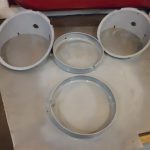
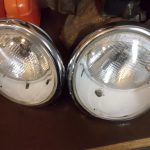

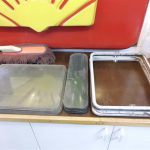
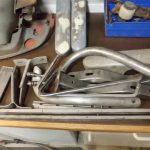
Sandblasting Small Parts, Finished Gauge Repairs
With the colder weather I’m limited to painting only small parts, the garage is heated but painting requires so much ventilation that the temperature drops below the paint minimum temperature. If the catalyzed automotive paints I’m using (epoxy, acrylic urethane) drop below their minimum temperature during the curing process, the molecular cross-linking stops and the paint is permanently in a gooey state. So since I’m limited to painting small parts for a while I needed a way to strip the paint and rust from all the various small parts. Sandblasting is a quick way to do this. However I had no way of recovering the blasting media, making blasting completely impractical, messy, and wasteful for small parts. To solve this problem I found a (deeply discounted) blasting cabinet that will enable blasting the small parts inside without using excessive amounts of blast media. After the performance today I wish I had gotten this a while ago because the results are much better than can be obtained by hand, infinitely faster, and with barely any effort required.
After many parts were blasted I finished the gauge restoration. The broken fuel gauge needle was replaced with a section of a “T” pin and painted to match the other two gauges. The sunburned celluloid indicator light lenses on the back of the speedometer were replaced with new lenses. Finally, everything was re-assembled including repainted light rings for all the gauges.
Steering Wheel Primer
Speedometer and Clock Restoration
Taking another break from painting/sanding, I worked on cleaning up the speedometer and clock. The speedometer was in generally OK condition but needed some polishing. In the process of disassembly and polishing the bezel and glass I found that the light ring needed repainting. The light ring is the khaki-colored ring between the glass and gauge face, it reflects light from the back of the gauge housing onto the gauge face. In other words the gauges do not have illuminated numbers like a modern car, instead the effect is more like holding up a flashlight to the gauge face.
The clock had the same cosmetic issues with the bezel, lens, and light ring. Additionally the clock’s hands had faded badly and the mechanism was not working when connected to 12V. The hands were repainted by carefully mixing model airplane paint to match the color of the speedometer hands (which also matches reference pictures online). After disassembling the clock mechanism I found the the fusible wire connecting the rewinding coil was broken. After the wire was re-soldered the clock fired right up. The clock is completely unlike the digital clock in a modern car (or modern anything) in that it is a mechanical action. The clock contains a spring, escapement, and flywheel just like a pocket watch and actually ticks while operating. When the spring gets close to unwinding a set of contacts closes and the aforementioned coil rewinds the spring.
Steering Wheel Restoration and Small Part Polishing
Work started on repairing the heavily cracked steering wheel. The wheel basically made of pressed wood fiber (like MDF) coated in a bakelite (primitive 1960’s plastic) shell. As the bakelite aged and cracked it allowed humidity in the air to swell the wood fiber and create more cracks. A “V” groove was cut in every crack to allow application of epoxy resin, which was then sanded flat with the wheel surface. Epoxy primer will then coat the entire wheel to seal out moisture and stabilize the wood fiber, followed by a catalyzed acrylic urethane in the original white color. Also, to take a break from painting/sanding, many small parts were polished with great results.









